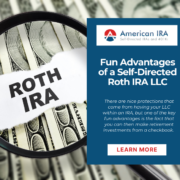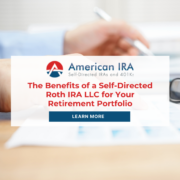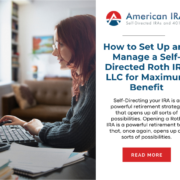Setting Up a Self-Directed Roth IRA LLC: A Step-by-Step Guide
A Self-Directed Roth IRA is powerful. It lets you put away after-tax money—which comes with more flexibility in an IRA—to fund your retirement. But holding an LLC within that Roth IRA? That’s another way of investing entirely. And it may be one that suits your unique investing style to a T. So let’s explore this idea more. This step-by-step guide will walk you through setting up your Self-Directed Roth IRA LLC, from choosing the right custodian to gaining checkbook control over your investments.
Step 1: Choose a Self-Directed Roth IRA Custodian
It all begins by having the right administrative firm in your corner. The first step? Setting up a Self-Directed Roth IRA LLC is to choose a custodian that specializes in these types of accounts. Not all custodians allow for alternative investments or the creation of an LLC within a Roth IRA, after all. That’s why it’s so crucial to find one with experience in Self-Directed IRAs.
Look for custodians that provide flexible investment options. They should offer support with IRS compliance and have reasonable fees. You’ll want a partner that can help guide you through the setup process and ensure that your account remains in good standing with the IRS.
Step 2: Open Your Self-Directed Roth IRA
Once you’ve selected a custodian, it’s time for the next step. You’ll need to open your Self-Directed Roth IRA. This process is like opening any other IRA account: you provide your personal information, funding sources, and any necessary documentation.
Remember, though: a Roth IRA differs from a traditional IRA in that contributions are made with after-tax dollars. This means that while you won’t receive a tax deduction for your contributions, your investments grow tax-free. And withdrawals in retirement are also tax-free—provided that you’ve stuck to the IRS rules while investing.
Step 3: Fund Your Self-Directed Roth IRA
Next, you’ll need to fund your Self-Directed Roth IRA. You can do this a number of ways. Maybe that means transferring funds from an existing Roth IRA, or rolling over funds from another retirement account. If you’re transferring or rolling over funds, you’ll want to plan it in advance to ensure you don’t get any penalties for carrying out the process the wrong way.
Step 4: Create Your IRA-Owned LLC
To gain checkbook control over your Self-Directed Roth IRA investments, the next step is to form an LLC that your Roth IRA can own. This LLC will act as the vehicle for your checking account to help you establish checkbook control with your Roth IRA. You can use it to manage your investments, which allows you to make investment decisions quickly.
Need help? Work with an attorney or use an online LLC creation service to establish the LLC. You’ll need to draft an operating agreement that specifies that the Roth IRA is the owner of the LLC and outlines its structure as a Single Member LLC.
Another quick note? After forming your LLC, you’ll need to obtain an Employer Identification Number (EIN) from the IRS. This number is used to identify your LLC for tax purposes and is necessary for setting up a business bank account in the LLC’s name.
Step 5: Open a Business Bank Account
With your LLC formed and an EIN in hand, the next step is to open a business bank account for your LLC. This account serves as the holding place for your Roth IRA funds. It’s how you can write checks from within the Roth IRA—and continue to do so as long as the LLC and Roth IRA remain in good standing.
Interested in learning more about Self-Directed IRAs? Contact American IRA, LLC at 866-7500-IRA (472) for a free consultation. Download our free guides or visit us online at www.AmericanIRA.com.







